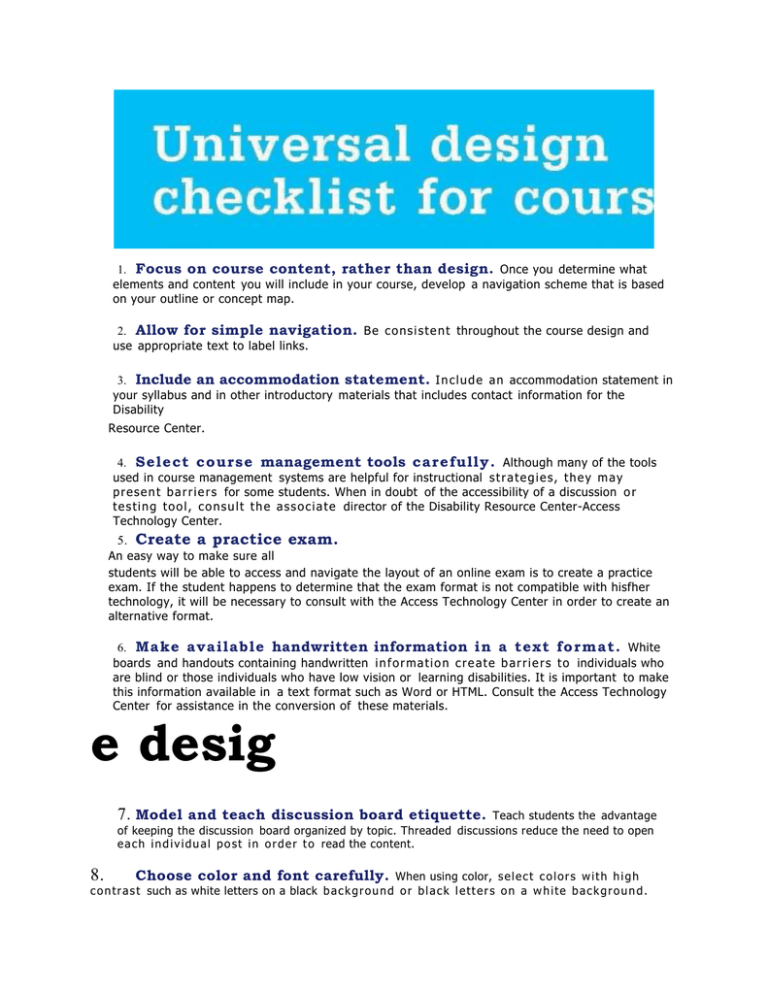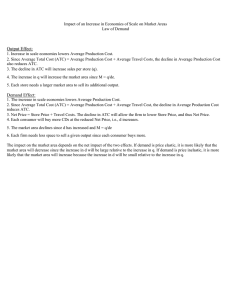Document 15387329
advertisement

1. Focus on course content, rather than design. Once you determine what elements and content you will include in your course, develop a navigation scheme that is based on your outline or concept map. 2. Allow for simple navigation. B e c o n s i s t e n t throughout the course design and use appropriate text to label links. 3. Include an accommodation statement. I n c l u d e a n accommodation statement in your syllabus and in other introductory materials that includes contact information for the Disability Resource Center. 4. Select course management tools carefully. Although many of the tools used in course management systems are helpful for instructional s t r a t e g i e s , t h e y m a y p r e s e n t b a r r i e r s for some students. When in doubt of the accessibility of a discussion o r t e s t i n g t o o l , c o n s u l t t h e a s s o c i a t e director of the Disability Resource Center-Access Technology Center. 5. Create a practice exam. An easy way to make sure all students will be able to access and navigate the layout of an online exam is to create a practice exam. If the student happens to determine that the exam format is not compatible with hisfher technology, it will be necessary to consult with the Access Technology Center in order to create an alternative format. 6. Make available handwritten information in a tex t format. White boards and handouts containing handwritten i n f o r m a t i o n c r e a t e b a r r i e r s t o individuals who are blind or those individuals who have low vision or learning disabilities. It is important to make this information available in a text format such as Word or HTML. Consult the Access Technology Center for assistance in the conversion of these materials. e desig 7. Model and teach discussion board etiquette. Teach students the advantage of keeping the discussion board organized by topic. Threaded discussions reduce the need to open e a c h i n d i v i d u a l p o s t i n o r d e r t o read the content. Choose color and font carefully. When using color, s e l e c t c o l o r s w i t h h i g h c o n t r a s t such as white letters on a black b a c k g r o u n d o r b l a c k l e t t e r s o n a w h i t e b a c k g r o u n d . 8. C h o o s e a s a n s serif font such as Anal or Helvetica f o r y o u r t e x t a n d m a k e s u r e t h e font size is large enough to be read comfortably. Note that some students may not be able to see color, so using color alone to convey meanings is not an affective practice. 9. Provide documents in an accessible format All course documents, including PowerPoint presentations, should be made available in an alternative format such as Word, PDF or HTML. For assistance in converting documents into an accessible format consult the Access Technology Center. If it's visual 10. - m a k e i t auditory; if it's auditory - make it visual Making course materials available in a variety of formats allows for students of all learning styles to better absorb and process course information. If you have a st udent in your course who is blind or has low vision, or is deaf or hard of hearing; it will be necessary to make all these formats available. Again, you can consult the Access Technology Center to make these material conversions. — ADAPTED FROM PROJECT PACE, UNIVERSITY OF ARKANSAS-LITTLE ROCK Missouri C DI State_ INCLUSION \MTN& U N I V E R S I T Y _ Md. "Tea 41 611 . 1111111114: • 411 11 AL_V 7 ATC also supports technology across campus at the Learning Diagnostic Clinic, Disability Resource Center and BearCLAVV, as well as computer labs in Cheek and Glass halls. Conversion of textbooks and academic materials The ATC staff makes every effort to provide textbooks and academic materials to students in their preferred alternative format, which includes: Electronic text — DOC, RTF and PDF Audio — Daisy and MP3 Braille 4 Large print ;WW1HMO ‘■ AI ALI Al The Access Technology Center (ATC) is a vital part of the Disability Resource Center. It is a campus resource for faculty, staff and students with disabilities, as well as for those who design programs and curricula. Through the use of technology, ATC creates more inclusive learning environments for those with disabilities. Services include: Equipment and technology review A s s i s t i v e t e c h n o l o g y t r a i n i n g Technology research assistance to enhance learning environments Consultation to creating equitable participation experiences for students Outreach opportunities to the local community The ATC is staffed and located in Meyer L i b r a r y r o o m s 2 0 1 B - 2 0 1 G a n d i n c l u d e s five workstations. The Center maintains an up-to-date inventory of additional access technology equipment and software for s t u d e n t s t o c h e c k - o u t f o r t h e s e m e s t e r and for placement in classrooms, labs and internship sites. All ATC lab stations provide access to the following: Close circuit televisions (CCTVs) PC or Mac Keyboard and mouse alternatives Scanners Speech recognition software Screen reading software Screen magnification software Scanning software mess Technolog Center FA Fl I 11 1 ill II 11 MI IMITOII1M11 16111 MOO • 0 1 N A T I O N A L A V E . , P R I N F I E L D , VI 6 5 8 9 7 . Web: www.missouristate.edu/atc Email: ATC@missouristate.edu Phone: 417-836-4275 .- • • _ Is — 0 MEGAN SHADRICK, MA, MS, _ COMS, ASSOCIATE DIRECTOR, ACCESS TECHNOLOGY CENTER issouri _tate University a. eres to a strict non. iscrimination po icy an. .oes not iscrim mate on t e .asis o race, co or, re igion, sex, national origin, ancestry, age, disability, veteran status, or on any basis (including, but not limited to, political af filiation and sexual orientation) not related to the applicable educational requirements for students in any program or act ivity offered or sponsored by the University. Prohibited sex discrimination encompasses sexual harassment, which includes sexual violence. DSV 101 13

